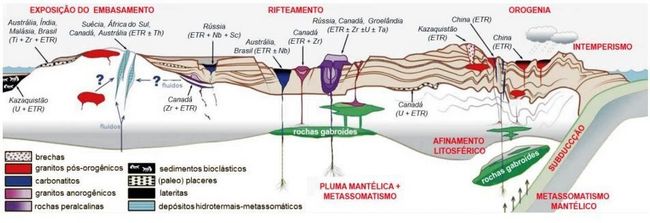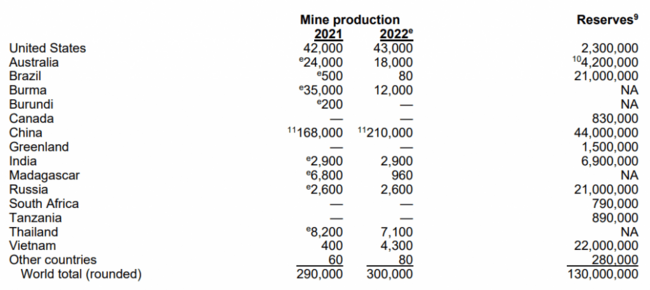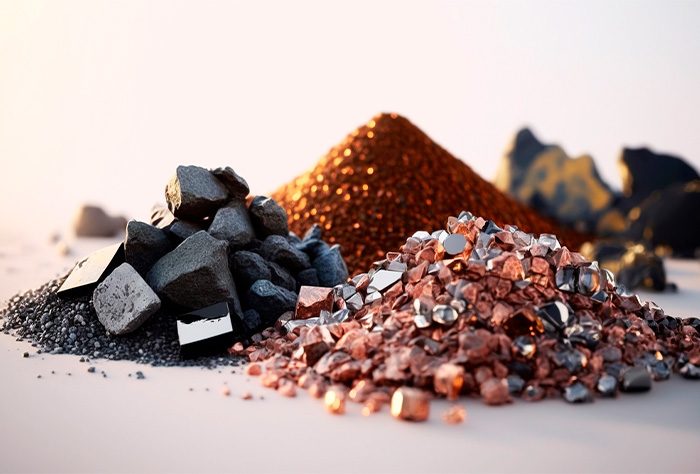What are REEs?
Rare earth elements (REEs) are a group of 17 chemical elements that have similar physical and chemical properties. They are used in a variety of technological applications, such as magnets, batteries, lasers, catalysts, and screens. Despite their name, some REEs are quite abundant in the Earth's crust, such as cerium and neodymium. However, separating the rare earth elements is difficult.
WHAT ARE RARE EARTH ELEMENTS (REES)?
REEs are divided into three groups: light, medium, and heavy. The mild ones have low atomic numbers (from 57 to 60) and are more common in nature. The middle ones have intermediate atomic numbers (from 61 to 65) and are less abundant. Heavy vehicles have higher atomic numbers (from 65 to 71) and are the rarest and most valuable.




Below we present all the rare earth elements and their respective atomic numbers.
Light:
- Scandium (Sc) (z = 21);
- Yttrium (Y) (z = 39);
- Lanthanum (La) (z= 57);
- Cerium (Ce) (z= 58);
- Praseodymium (Pr) (z=59);
- Neodymium (Nd) (z= 60).
Medium:
- Samarium (Sm) (z= 62);
- Europium (Eu) (z= 63);
- Gadolinium (Gd) (z= 64);
- Promethium (Pm) (z= 61).
Heavy:
- Terbium (Tb) (z= 65);
- Dysprosium (Dy) (z= 66);
- Holmium (Ho) (z= 67);
- Erbium (Er) (z= 68);
- Thulium (Tm) (z= 69);
- Ytterbium (Yb) (z= 70);
- Lutetium (Lu) (z= 71).
Of the 17 rare earth elements listed above, 15 are members of the lanthanide series. The remaining two, scandium and tritium, are transition metals included in the rare earth series, as they often occur mixed with lanthanides in the same deposits.
The main minerals that contain REEs are: monazite, bastnasite, xenotime and loparite, in addition to lateritic clays that absorb ions. These minerals can be found in igneous, sedimentary and metamorphic rocks, as well as in alluvial and residual deposits.
GEOLOGY AND MINERALOGY OF RARE EARTHS
According to the Natural Environment Research Council , there are over 200 minerals that contain rare earth elements. These elements can occur in a wide variety of mineral and structural classes. However, they are most commonly found in the form of carbonates, phosphates, silicates, fluorides, and oxides.
Bastnasite is a rare earth fluorocarbon that contains approximately 75% rare earth oxides in its composition, with the predominant elements being cerium (Ce), lanthanum (La), neodymium (Nd) and, to a lesser extent, praseodymium (Pr). On the other hand, monazite is a phosphate with a rare earth oxide content similar to bastnasite but has significant levels of thorium (0 to 20%) and uranium (0 to 16%), which makes it radioactive and difficult to extract.
Xenotime is a phosphate that has a rare earth oxide content of 60%, and is considered the main source of heavy rare earths, along with ionic clays. In addition, some minerals such as apatite, pyrochlore and zircon may have significant levels of rare earths, even though they are not classified as sources of these elements.
Rare earth elements (REEs) are found in low concentrations in the Earth's crust, but can be found in a variety of geological environments, both endogenous and exogenous. Endogenous deposits originate from within the Earth's interior. They are related to geothermal and tectonic activity. Examples include the formation of igneous and metamorphic rocks, as well as the creation of mineral deposits associated with magmatic intrusions and volcanic activity. Exogenous deposits originate at or near the Earth's surface and are caused by external forces such as weathering, water, and gravity. Examples include erosion, sedimentation, and the formation of sedimentary rocks. Exogenous mineral deposits, such as placers (deposits of heavy minerals formed by the action of water currents), are formed by weathering and sedimentary transport processes.
Below we highlight some deposits according to the geological environment, and the image below shows the tectonic environments that form rare earth deposits and the associated rocks.
Endogenous environments: Mountain Pass (USA), Bayan Obo (China), Pitinga (AM).
Exogenous environments: Araxá (MG), Vitoria (ES), São Gonçalo (MG).




WHAT IS THE IMPORTANCE AND APPLICATION OF RARE EARTH ELEMENTS?
Rare earth elements are essential components in a variety of products with a wide variety of applications, especially in everyday technological devices such as smartphones , hard drives, computer monitors, televisions, and electric vehicles. REEs also have a variety of applications in medicine, lasers , radars, and sonars.




Although the amount of REEs used in a product may be relatively small in terms of weight or volume, they are essential for the functioning of these devices and, in some cases, can also have a significant value in the composition of these materials. For example, magnets made of REEs represent only a tiny fraction of the total weight; without them, induction motors would not be possible. They are also used in agriculture and energy. Therefore, REEs are considered strategic for the economic and scientific development of several countries. See below the main markets that use Rare Earths:
Main uses of ETRs in batteries:
1 – Nickel-Metal Hydride (NiMH) Batteries:
- Lanthanum (La): Used as a major component of NiMH batteries, which are widely used in hybrid vehicles such as the Toyota Prius.
- Cerium (Ce), Praseodymium (Pr), Neodymium (Nd): Can also be used in smaller quantities in NiMH batteries.
2 – Lithium-Ion Batteries (Li-ion):
- Although REEs are not primary components in lithium-ion batteries, they can be used in auxiliary components such as alloys and coating materials to increase battery efficiency and durability.
Economic Importance:
- High Demand and Economic Value : Due to the increasing demand for electric vehicles, hybrids and other electronic devices that use rechargeable batteries, the demand for ETRs has increased, making their value significant in the market.
- Supply Dependence : REE production is concentrated in a few countries, mainly China, which can affect global supply and prices. This makes REEs strategically and economically important.
Impact on industries:
Automotive : The automotive industry, especially in the hybrid and electric vehicle segment, relies significantly on REEs for the production of efficient, high-capacity batteries.
- Electronics : Electronic devices that use rechargeable batteries, such as smartphones, laptops, and cordless tools, also contribute to the demand for ETRs.
In summary, the use of REEs in batteries has significant value from both a technical and economic point of view, influencing several industries and global markets.
RARE EARTHS IN BRAZIL
In Brazil, the presence of rare earths is identified in the monazite sands of the coast, in addition to being found mainly in deposits close to inactive volcanoes. The largest reserves identified in Brazilian territory are located in Amazonas, in the Seis Lagos area, Araxá (MG) in the Barreiro Complex, Poços de Caldas (MG) in Morro do Ferro and in Catalão (GO).
Despite having one of the world's largest reserves of rare earths, Brazil is not among the largest producers of these elements due to the high cost of extraction and separation technology, forcing the country to import these elements to use as raw materials in industries. However, this scenario may change in the coming years due to high demand and high foreign investment in the sector.
According to the National Mining Agency , there are currently 648 processes for Rare Earths in Brazil, of which 111 are research authorizations, 14 mining concessions and 523 applications. Most of these processes are from the last 3 years.




In 2022, there was a significant increase in the number of research requests filed by the National Mining Agency (ANM). The number jumped from 90 in 2021 to 154 in 2022. The number of approvals also increased from 1 in 2020 to 7 in 2022.




Large rare earth projects are already under development in Brazil. Among them, we can highlight the company Serra Verde Pesquisa e Mineração Ltda , which began commercial production of mixed rare earth concentrate in Minaçu (GO). The company began commissioning the first phase of operations in June 2023, and production in January 2024. The concentrate contains a combination of neodymium (Nd), praseodymium (Pr), terbium (Tb) and dysprosium (Dy). The company's goal is to achieve an annual production of at least 5 thousand tons of rare earth oxide over 25 years.




Several foreign companies have been paying attention to Brazil and are beginning to invest more and more in rare earths. The Canadian company Appia Rare Earths , for example, has reached an agreement with 3S Ltda and Beko Invest to acquire up to 70% of the stake in the rare earth project in Cachoeirinha (GO).
THE CHALLENGES OF EXPLORING ETRs
The exploration of rare earth metals faces several challenges:
Complexity of Extraction and Processing: Rare earths are rarely found in high concentrations, making extraction and processing complex and expensive.
Environmental Impact: Mining and processing can cause significant environmental damage, including water and soil pollution.
Geopolitical Dependence: Production is dominated by a few countries, such as China, which can create vulnerabilities and strategic dependencies.
Strict Regulation: There are strict environmental regulations in many countries that can limit exploration and production.
Recycling Technology: Recycling of rare earths is still limited and faces technical and economic challenges, making it difficult to reuse these metals.
These challenges make the exploration of rare earth metals a complex and strategic field.
The world's leading producers of rare earths are China, the United States, and Australia. China is the world's largest producer, accounting for over 60% of global annual production in 2022 (Source: U.S. Geological Survey – 2023). In addition to these countries, other major producers are: Burma, Vietnam, Thailand, and India.




China has increasingly established itself as the world's largest producer of REEs, with 210,000 tonnes of rare earths extracted in 2022, 25% more than in 2021 (168,000 tonnes). According to the United States Geological Survey , global reserves of rare earths in 2022 total 130 million tonnes, and the countries with the largest reserves are: China, Vietnam, Russia and Brazil.




RECYCLING RARE EARTHS, AN ALTERNATIVE TO EXPLORATION
China's hegemony in the Rare Earths market places other countries in a position of dependence and vulnerability, especially in scenarios of geopolitical tension or supply shortages.
To address this challenge, a team of researchers led by Victor Mougel from the Laboratory of Inorganic Chemistry at ETH Zurich has developed an innovative method for the efficient recycling of rare earth metals. Recently published in the journal Nature Communications, the study presents a process based on tetrathiometalates, inorganic molecules that have demonstrated unique redox properties. These compounds act as ligands that facilitate the separation of rare earth metals from complex mixtures, enabling more efficient, faster and sustainable recovery.




By prioritizing recycling over mineral extraction, this approach not only preserves precious resources and reduces negative environmental impacts, but also offers a practical and cost-effective solution to address global supply challenges for strategic metals. The initiative by Swiss researchers not only represents a significant scientific breakthrough, but also promises to transform the current paradigm of consumption and disposal of technological products, towards a more sustainable and resilient future.
SOURCES:
http://recursomineralmg.codemge.com.br/wp-content/uploads/2018/10/TerrasRaras.pdf
http://recursomineralmg.codemge.com.br/substancias-minerais/terras-raras/
https://ibase.br/wp-content/uploads/2022/02/Terras-raras-e-niobio_Julio-Holanda.pdf
